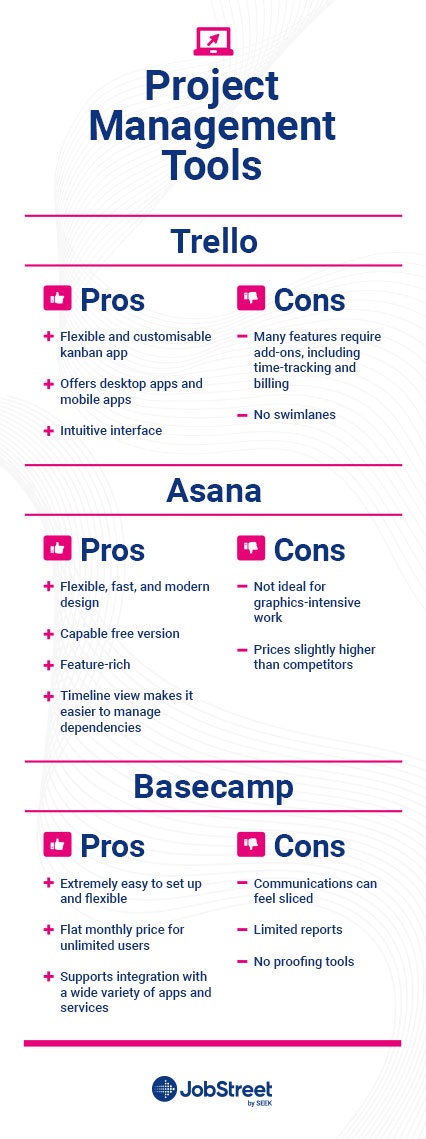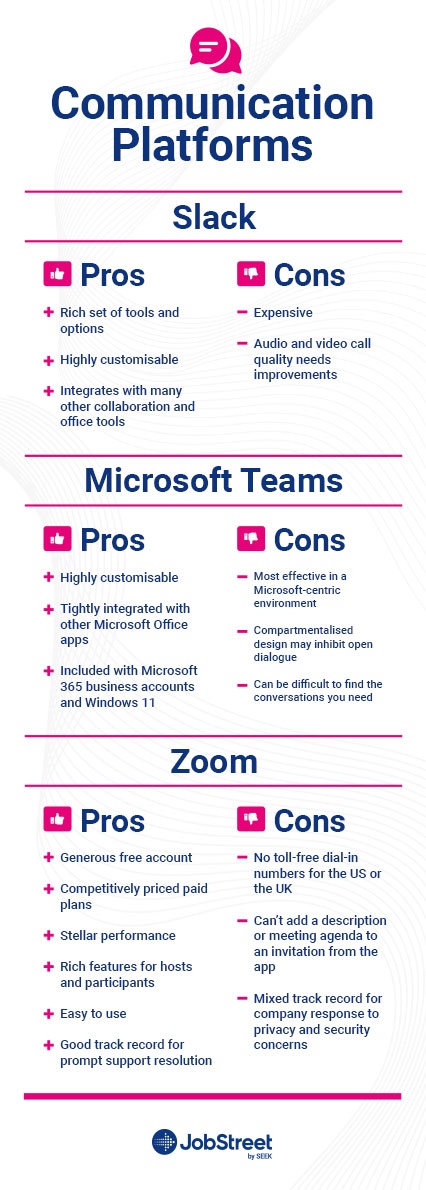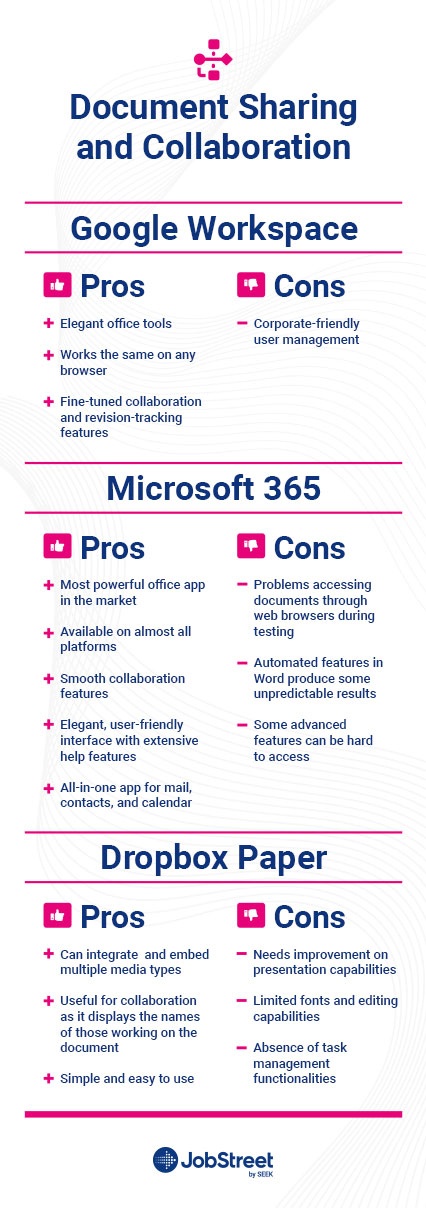Improving your collaboration skills: how to be an effective team player at work
Introduction
There is a reason why collaboration skills are often regarded as one of the most in-demand soft skills in the market. After all, they rank second in the top 10 most important skills desired by employers.
But just what are collaboration skills and what are their importance in the modern workplace? And which collaboration skills should you include on your resume?
Imagine this. Say, you’re in your early 20s and you just completed your apprenticeship. As you read your resume, you feel that nothing stands out from this initial work experience that you would want added to improve your resume.
But wait. There are a few remarks given by your immediate supervisor on the last part of the recommendation. It states: “Possesses good rapport and is always ready to take one for the team. Reliable in setting up and introducing the hybrid workplace for Zoom meetings, Google Workplace, etc.”
You ask yourself, “What skills were my supervisor pointing out? And how can I add these skills to my resume?”
These remarks represent your collaboration skills. In a nutshell, collaboration skills are the abilities and behaviours you use when working with others in a team to produce a commonly desired result. This is the garden variety definition of collaboration skills, also referred to as collaborative skills.
One of our examples of collaboration above shows the use of communication to establish good relationships (rapport). It also shows the use of collaboration tools and techniques (Zoom, Google Workplace).
It is a particular group of different soft skills and behaviours that includes many diverse things under its hood: emotional intelligence, problem-solving techniques, collaborative communication, open-mindedness, etc. This article lists the most sought-after collaboration skills essential for success in today’s workplace.
- The foundations of collaboration skills
- Collaborative problem solving
- Adapting to different team dynamics
- 19 best collaboration skills to list on your resume
- Collaborative tools and techniques
- Cultivating a collaborative mindset
- Conclusion
- FAQs
The foundations of collaboration skills
Let us face it, it is hard to measure interpersonal skills. How could one truly gauge how a player motivates his or her teammates to play their hearts out in a game to get the big W? While generally soft skills are not quantifiable, most examples of collaboration or collaborative work could be effectively presented on a resume using the three foundations of collaboration skills as a guide, namely: communication, emotional intelligence, and trust-building.
Communication and collaboration
Communication and collaboration are directly related to each other. According to a recent Forbes article, in 2023 the communication tools in the modern workplace, in particular those that fall under the category of digital communication tools such as the landline, mobile phones, Microsoft Teams, etc., are must-haves for 58% of workers.
While communication is primarily concerned with the exchange of information between sender and receiver, collaboration is more involved with how successfully a piece of information is disseminated to achieve a common purpose.
All examples of working collaboratively will categorically show that communication is an essential tool for teamwork in the workplace. Certain communication skills, of course, stand out as valuable principles that would help jobseekers in the enhancement of their collaboration skills.
Active listening is a basic communication skill that facilitates collaborative tasks and functions in the workplace. It leads to both the sender and receiver of the information having to express not only their ideas clearly, but also to achieve their common goals. Understanding what is being said is also an essential factor in conflict reduction and resolution. With active listening, understanding adds more value in the workplace than responding.
Some active listening techniques are:
- Practising good eye contact
- Asking open-ended questions
- Utilising non-verbal cues (posture, facial expression, the way you present yourself)
Emotional intelligence
The ability to put yourself in another person’s shoes is a soft skill that reveals your emotional intelligence. There are valid reasons why employers encourage empathy in the workplace.
Empathy cultivates self-awareness in the office. It also bridges the communication gap that so often hinders workers from being aware of and open-minded to certain company policies and procedures, like self-regulation, respect in the workplace, promotion of diversity, equity, and inclusion.
Trust-building
There can be plenty of ways to build trust in the workplace. It can be as simple as your boss asking you to compute expenses from a business trip or to track the progress of someone your company is training.
Along with being honest and transparent, dependability is also a big factor in trust-building. For example, does your manager trust you enough to take care of company business while he or she is attending a week-long convention?
In short, trust improves teamwork and cooperation in the workplace. With trust, collaboration, and communication become less difficult for everybody.
Keep in mind that trust should also maintain a sort of balance, a quid pro quo, and a keen sense of the relationship between collaboration and communication, keeping in mind the long-term growth of the company and its employees.
Collaborative problem solving

According to a Forbes article, certain collaborative problem-solving techniques help employees identify their common goals. These can also guide them in brainstorming, idea generation, and implementation.
Often, we can hear people in the office tell us to “get creative” when trying to resolve an issue. Part of being creative is having to harness together the ideas and actions of all team members to solve a problem. We often fall into the trap of trying to solve things alone and presenting our findings instead of working together toward a common solution.
One way we can address this is by exercising our interpersonal skills, like being open-minded or understanding divergent and convergent thinking.
Open-mindedness and awareness of both divergent and convergent thinking are key to achieving collaboration and teamwork in the office. Creativity, ingenuity, and discretion can also be considered key when faced with the challenges of divergent and convergent thinking in collaboratively solving problems.
From there, we can come up with clearer development action plans. This part of the collaborative problem-solving process involves not only the required documentation but also debriefings if necessary. This closes the collaboration and teamwork loop that spells success for both the company and its people.
Adapting to different team dynamics
Team dynamics
A term first utilised by social psychologist Kurt Lewin, team dynamics can be defined as the factors related to the roles and the effect of behaviours of team members on each other and the group as a whole.
Studies show these interactions and interrelationships make team members develop their collaboration skills. Good team dynamics utilise communication, interpersonal, problem-solving, and many other soft skills to achieve strength and coherence in the team. In essence, team dynamics, or group dynamics, can make or break collaboration and teamwork in a workplace.
There are different team dynamics. These include:
- Psychological safety
Psychological safety is similar to safe space in a workplace. It encourages a team member to speak up and put forward ideas and suggestions to the team.
- Dependability
Dependability is the ability to take on tasks responsibly.
- Structure and clarity
Structure and clarity as team dynamics refer to fully understanding the roles and functions of each member and how these are all created to achieve a common purpose.
- Meaning of work
Meaning of work is about assessing the value of your work to your team as well as to yourself.
- Impact of work
Impact of work refers to how your contributions factor in the success of your team and your shared goals.
Assessing your teammates
There are also two types of assessment frameworks that can help you approach your group dynamics better. The Belbin Team Role Theory and the Myers-Briggs Type Indicator serve as good tools to evaluate your teammates. These can be good guides to understanding how each person responds, functions, and behaves within a team setting.
Belbin team role theory
A theory developed in 1981 by British researcher and management consultant Meredith Belbin, it is structured with 9 team roles that will predict the success or failure of a management team.
According to a University of Cambridge study, the 9 team roles are as follows:
- Resource investigator:finds ideas and resources for the team
- Teamworker:gets things done
- Coordinator:makes sure everyone contributes
- Plant:the creative brain
- Monitor evaluator:provides a strategic and logical perspective
- Specialist:brings specialised knowledge and expertise
- Shaper:challenges and motivates the team to move forward
- Implementer: organises the team and plans out the implementation strategy
- Completer finisher:provides quality control for the completed project
The primary use of team roles is that it helps a team member assess his or her role in the management team. According to the theory, a well-maintained equilibrium of the nine roles utilising soft skills, like collaboration skills, will more likely spell success in the workplace.
Myers-Briggs type indicator
According to the Myers & Briggs Foundation, the objective of the personal inventory called Myers-Briggs Type Indicator is to apply in real life the theory of psychological types defined by Carl Jung in his writings. Similar to the Beblin Team Role Theory, this instrument aims to recognise and characterise the different personality types which are borne out of the interactions among the so-called preferences.
As a useful tool for collaboration and communication in the workplace, the Myers-Briggs Type Indicator, along with the Beblin Team Role Theory, can provide team managers with an effective assessment framework to identify and describe the roles of each team member concerning the accomplishment of their common goal.
These tools can prove very useful for conflict resolution and motivation in the workplace. Conflict reduction and resolution will always take up a large chunk of collaborative problem-solving. Motivation, as indicated in the foundation of collaboration skills, results from good communication skills, empathy, and even emotional intelligence.
In terms of feedback and recommendations, these tools help employees adapt to different team dynamics by letting all members of the team share their voices. And, in collaboration with management, be able to formulate and develop action plans that will fit their team’s culture and organisation.
Eventually, these assessment tools also become skills-building and management tools. In the long run, they will facilitate the development of collaboration skills of the entire team.
19 best collaboration skills to list on your resume

Here are the 19 best collaboration skills and a few of their techniques to list on your resume.
Active listening
- Practice empathy by expressing concern about what is being said
- Ask open-ended questions
- When asked for your opinion, speak your mind, but show respect to everybody
Teamwork skills
- Build your oral and written communication skills
- At times, collaborative problem-solving techniques cannot be found in the book; learn to think on your feet
- Build honesty and transparency; maintain a balance between empathy and accountability
Flexibility and compromise
- Understand the value of compromise, or what you are compromising on
- Be transparent with your intentions
- Make multiple and sensible suggestions
Interpersonal relationships
- Interact with your co-workers more often
- Attend meetings and other official functions more often
- Find time to talk with your peers aside from the perfunctory hello and goodbye
Conflict resolution
- Use active listening for discernment
- Develop and follow through on your plan of action to resolve the conflict
- Lean on policies and precedents to explain the resolution
Open-mindedness
- Go out of your comfort zone
- Engage, agree to disagree
- Try to keep everybody involved in the decision-making process
Constructive feedback
- Build trust
- Make sure the feedback is constructive and not destructive
- Do not make feedback a personal tool
Organisational skills
- Document everything
- Familiarise yourself and use both traditional and modern filing systems
- Set the hierarchy of access for all team members
Remote collaboration
- Use your communication skills, both basic and advanced
- Transfer of knowledge is key
- Always create backups at every phase of the remote collaboration setup
Collaborative tools
- Familiarise yourself with collaborative tools such as chat apps, video conferencing
- Make sure that the network in the workplace is accessible to everybody
- Set training and lectures to update the collaborative knowledge of all team members
Project management
- Use visual aids like boards and diagrams
- Monitor progress reports regularly
- Conduct regular ocular inspections
Meeting facilitation
- Dissemination of the purpose is important
- Always be punctual
- Always be respectful
Task delegation
- Clarify the priorities of the team
- Know the strengths and weaknesses of each team member
- Continuous training is a must for the effective delegation of tasks
Team motivation
- Share your goals with the team
- Encourage participation and consultation
- Create space for the growth and development of team members
Conflict management
- Clarify the conflict’s source by actively listening to all sides
- Respect divergent thinking and dwell on agreements, not disagreements
- A hands-on investigation of the conflict
- Teach yourselves how to handle and move forward even with certain disputes
Creative problem-solving
- Ask the hard questions and try to answer all of them
- Create more than one action plan
- Brainstorming and creating real-life workspace scenarios and solutions
Data analysis
- Remember that every piece of information is as useful as the source it came from
- Use the two-pronged approach to analysis: qualitative and quantitative
- The integrity of data is of primary importance
Communication skills
- Think first before you say something
- Be proactive in bridging communication gaps
- Be consistent in establishing lines of communication
Empathy and understanding
- Let care and curiosity be a positive part of the office culture
- Always be open to constructive feedback and actionable suggestions
- Join a meeting and share your voice in the ongoing conversation
Collaborative tools and techniques
If you go to Stanford University’s collaboration tools web page, you will immediately have an initial understanding of what collaboration tools are. Collaboration tools are the system software utilised in the workplace for ease of collaboration and communication, project management, and sharing documents and files.
Project management tools
Management of the resources of the company for a certain project requires planning and organisation. Project management tools are essential in facilitating such tasks. According to PC Magazine, here are some of the best online collaboration software for today’s modern workplace.

Communication platforms
A Harvard Business Review article found that redistribution of work is necessary for effective collaboration. Non-delegation of tasks may likely lead to collaborative overload, or where some team members are overworked with non-priority work while collaborating with their peers. Communication platforms, therefore, are essential tools in helping the team make informational and social resources more available to all.

Document sharing and collaboration
In real-time, document sharing and collaboration tools bear the brunt of the day-to-day team communication needs in the workplace. Good collaboration skills and behaviours translate to the effective and efficient use of document sharing and collaboration tools.

Cultivating a collaborative mindset

Promoting collaboration in the workplace is hard work
Let’s face it, teamwork is work, or to be more specific, hard work. From the initial planning and organising to the implementation and establishment of team roles, to the eventual monitoring and evaluation, up to the latter stages of conflict management and rewarding the team for a job well done, collaboration work seems to be never-ending.
Here are some of the surefire ways of cultivating a collaborative mindset in the workplace.
Seeing the devil in the details as well as the big picture
A collaboration-intensive workplace encourages growth and development among co-workers. To commit yourself to promoting a collaborative culture within your organisation, you must show each team member the value of their contributions to the greater scheme.
Team management should make sure team members understand that the primary purpose of delegating tasks is to promote a sense of responsibility and accountability, and not to create conflict and misunderstanding.
You can do this through open lines of communication, self-awareness, and empathy, among others. Establishing interpersonal relationships and promoting inclusivity are some of the other things that help strengthen collaboration skills, too. Rewards and team-building exercises aren't such bad ideas either.
Visit JobStreet’s Career Advice page for more tips on managing employees and your career. #SEEKBetter jobs by downloading the JobStreet app from App Store or Google Play so you can find the work that matters to you anytime, anywhere.
Conclusion
In this day and age, collaboration skills are practically required by employers. It says a lot about your character. This also explains how jobseekers like you are fair in the organisation.
Collaboration skills are key to the long-term growth and development of your career and personal life, as well as the team’s. It reflects on the members’ attitudes and interactions with each other.
In defining collaboration skills and their foundations, you have to create a roadmap on how to succeed in cultivating a collaborative mindset in the workplace. Collaboration and communication have a direct relationship with each other, after all. It means that a lack of communication is equal to poor collaboration.
While the article has provided 19 of the best collaboration skills jobseekers can include, it is, of course, open to change. The modern workplace, after all, is continuously rebuilt and redesigned to fit the needs of both employers and jobseekers.
FAQs
How can I improve my collaboration skills?
Create a safe space in the workplace where you can give and receive feedback and suggestions
Exhibit genuine concern for the challenges faced by you, by your teammates, and by the team as a whole
Be open-minded, and learn to accept diversity in the workplace
Be flexible, and try to practice diligently the art of compromise
What are some common challenges faced when collaborating with others?
Clash of personalities
Great resistance to change
Lack of or no clarity of purpose
Lack of or no reliable line of communication
The need to correct the wrong impressions about collaboration, such as the delegation of tasks complicates the workload, additional responsibility is not equivalent to your salary, and collaboration will lead to a more public and less private place of work
How do you handle difficult team members in a collaborative setting?
Actively listen
After actively listening, make sure to respond with as much honesty and transparency as possible
Actions are louder than words, so make sure to follow through with any decision made with the corresponding plan of action
Be open to feedback and suggestions
Monitor the progress of any decision implemented by doing debriefings with your team members, if necessary
How can introverts excel at collaboration?
Take great advantage of being a listener. As great active listeners, introverts notice details that others usually cannot; thus, introverts can spend time tweaking and tweening a project to make it better.
Create a safe space for introverts to create a team of their own. “Fortius ut”, or “Stronger as one”. Another purpose for the safe space is for introverts to find the team roles that best define and characterise them.
Use alternative modes of communication that are convenient for their personalities. For example, if they do not feel comfortable attending meetings face-to-face, you can make them do remote conferences.
Maintain a balance between empathy and accountability. Introverts can still grow in their careers and personal lives by knowing that somebody in the workplace cares for them, but at the same time pushes them to face their responsibilities.
How can remote teams enhance their collaboration skills?
Encourage regularly updated communication
Go the extra mile in disseminating prioritised information
The transfer of knowledge goes hand-in-hand with the transfer of technology. Thus, ensure remote teams are well-equipped with the system hardware, software, and middleware.
Manage conflict as expeditiously as possible.
Build a culture of trust and confidence among team members.
When it comes to remote teams, redundancy is a plus. Collaborative skills are best practised when everybody has synchronised their tasks according to a common goal.
